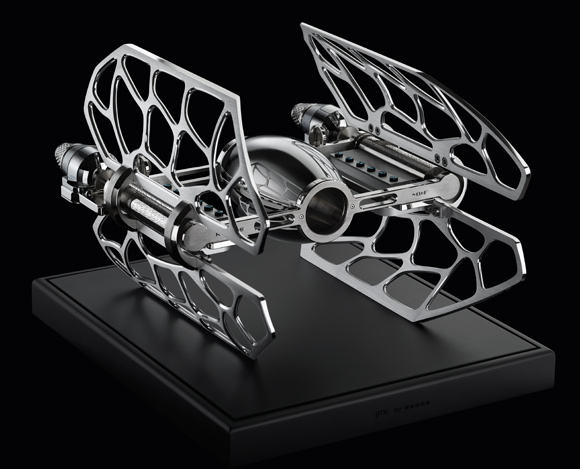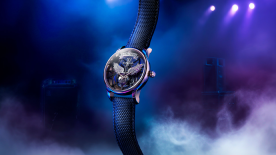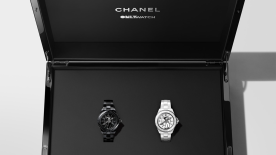Designed by MB&F and made by Reuge, the first MusicMachine was launched in 2013. Reuge and MB&F joined forces again in 2014 for MusicMachine 2 and today, for MusicMachine 3, which completes the trilogy.
MB&F celebrates its tenth anniversary in 2015 with the tagline “A creative adult is a child who survived.”
Inspired by the TIE fighters of Star Wars, MusicMachine 3 is proof positive that both the child and the Force are still going strong within MB&F founder Maximilian Büsser – who was 10 years old when he first saw Star Wars in 1977.

MM3 may appear to come from a galaxy far, far away in the future; however, it features all of the traditional elements of a beautifully arranged, high-end mechanical music box.
The music is powered by two independent movements mounted on the two tail sections. Each movement has its own winding key (disguised as thrusters), a mainspring barrel, horizontal cylinder with pins, and comb with hand-tuned teeth sounding each note. The cylinders play three melodies each. The right cylinder plays themes from Star Wars (1977), Mission Impossible (1960), and James Bond (1962), while the left plays themes from The Godfather (1972) by Nino Rota, Merry Christmas, Mr. Lawrence (1983) by Ryuichi Sakamoto, and The Persuaders (1971) by John Barry.
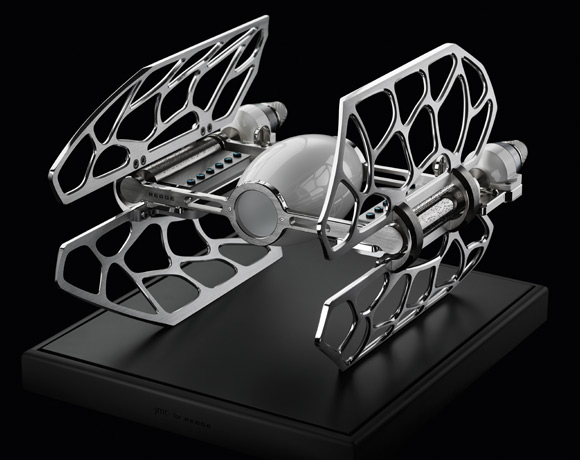
To ensure the lateral symmetry of MM3, Reuge broke with music box convention to configure the two movements as mirror images of one another. This required a complete inversion of the design of the movement components and the movement architecture so that one cylinder rotates clockwise and the other anticlockwise. The music box movements are fixed to two Geneva wave-decorated main plates (one each side) running from the “thruster” winders at the back to the front of the music cylinders.
The two combs lie flat beside each cylinder, each forming a unique pair containing the bespoke selection of 72 notes. The combs are hand-tuned from a unique steel alloy selected for its acoustic impact.
The hand-finished cylinders gleam like a pair of imposing power reactors. The cylinders essentially contain the melodies’ ‘scores’, with as many as 1,400 precisionplaced pins plucking the teeth of the comb as the cylinder revolves.
Frustums (truncated cones) resembling propulsion thrusters on each side of the tail section are actually winding keys that are linear with the mainspring barrels and cylinders. They revolve as the barrels unwind and the cylinders turn.
In the centre of the main plate are distinctive vertical circular panels. While these might look as though they could be radar dishes used for navigating an asteroid field, they are actually the cylinder speed regulators. When fully wound, the mainsprings have more torque so they tend to rotate the cylinders faster than when nearly unwound. To compensate, these circular fan air regulators provide exponentially more resistance when rotating faster than slower, allowing for a more constant revolution. A similar system is found in many minute-repeater watches.
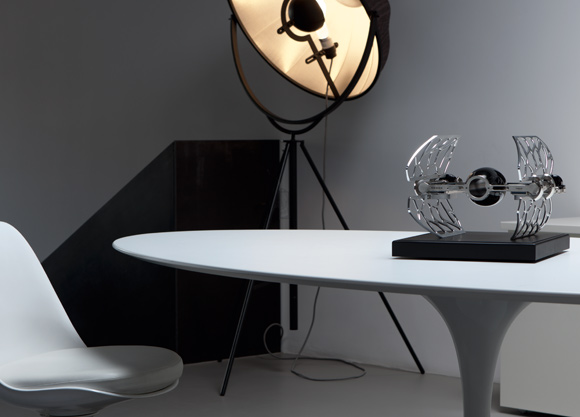
Functioning by the principle of forced vibration, wooden soundboards traditionally feature on stringed instruments such as violins, guitars and pianos. On MusicMachine 3, energy is transmitted from the vibrating teeth down though the vertical side wings to the resonance base, which not only amplifies the sound, but underlines the beauty of the music. MusicMachine 3’s innovative base combines 350-year-old resonance spruce with 21st century composite materials like NomexTM honeycomb Kevlar. This natural timber amplifier was developed by Jeanmichel Capt of JMC Lutherie, based in the Vallée de Joux, in the heart of Switzerland’s horological landscape.
MusicMachine 3 is a limited edition of 99 pieces: 33 pieces with white finish; 33 pieces with black finish; and 33 pieces with ‘chrome’ finish.
